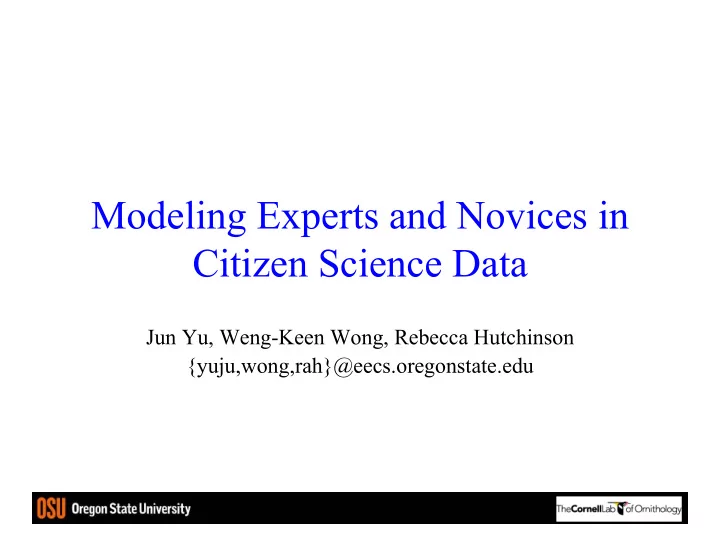

Modeling Experts and Novices in Citizen Science Data Jun Yu, Weng-Keen Wong, Rebecca Hutchinson {yuju,wong,rah}@eecs.oregonstate.edu
Introduction Species Distribution Modeling important for: • Understanding species- habitat relationships • Conservation and reserve design • Predicting effects of Predicted distribution of tree swallows across climate / land use change North America (from D. Fink) Many research questions require data to be collected at broad spatial and temporal scales
Introduction Citizen science: scientific research in which volunteers from the community participate as field assistants [Cohn 2008] Pros: Cons • Inexpensive • Reliability of data • Can collect data over large spatial areas and long time periods
Introduction • One of the largest citizen science programs • Online checklist database developed by Cornell Lab of Ornithology and National Audubon Society • Birders submit checklists of birds observed (> 1.5 million checklists in Jan 2010)
Introduction Can we use eBird data for accurate SDM? • Main issue: birders have different levels of expertise Novice Expert • How reliable is the data? – Data reviewed through a verification process – But biases still exist
Methodology Labeled Training Set Birder ID: 42 Birder ID: 56 Expertise: Expert Expertise: Novice Train model Blue Heron X Blue Heron X Blue Heron X Blue Heron X House Finch √ House Finch √ Blue Heron X House Finch √ House Finch X Blue Heron X Purple Finch X Purple Finch X House Finch √ Blue Heron X Purple Finch X Purple Finch X House Finch √ Tree Sparrow √ Tree Sparrow √ Purple Finch X House Finch √ Tree Sparrow √ Tree Sparrow √ Purple Finch X . . . . . . Tree Sparrow √ Purple Finch X . . . . . . Tree Sparrow √ . . . Tree Sparrow √ . . . . . . Use model 32 experts (2532 checklists) 88 novices (2107 checklists)
Methodology Detection Environmental Occupancy Covariates Detection Covariates (Latent) o i d it X i Z i Y it W it t=1,…,T i i=1,…,N Start with Occupancy-Detection (OD) model [Mackenzie et al. 2006]
Methodology Assumptions on OD model • Site closure assumption: species occupancy status stays the same over the site visits • No false detections: can’t detect a bird if it doesn’t occupy the site
Methodology Expertise Expertise v j Covariates E j U j j=1,…,M o i d it , f it W it Z i Y it X i t=1,…,T i i=1,…,N Occupancy-Detection-Expertise (ODE) model
Methodology ODE model details • Allow for false detections. Results in four sets of parameters: – True detection and false detection parameters for experts – True detection and false detection parameters for novices • Introduces an identifiability problem – Add constraint during training • Train using Expectation-Maximization
Results 1. Want to predict occupancy (Z i ) but ground truth not available. Instead, predicting observation (Y it ) – eBird data from NY, breeding season (2006-2008) – Expertise nodes observed in training data, unobserved in test data – Evaluating spatial data is challenging: use checkerboarding – Compare with Logistic Regression and OD model
Results Average AUC on four hard ‐ to ‐ detect bird species Average AUC on four common bird species 0.80 0.80 AUC 0.70 0.70 AUC 0.60 0.60 0.50 0.50 White ‐ breasted Northern Great Blue Blue ‐ headed Northern Rough ‐ Blue Jay Brown Thrasher Wood Thrush Nuthatch Cardinal Heron Vireo winged Swallow 0.6726 0.6283 0.6831 0.6641 LR 0.6576 0.7976 0.6575 0.6579 LR OD 0.6881 0.6262 0.7073 0.6691 0.6920 0.8055 0.6609 0.6643 OD 0.7104 0.6600 0.7085 0.6959 ODE 0.6954 0.8325 0.6872 0.6903 ODE
Results 2. Predict Expertise (E j ) of birder given checklist history – Site occupancy (Z i ) is unobserved in both training and testing – Two-fold cross-validation on birders – Repeat 20 times and report average AUC – Compare against Logistic Regression
Results Average AUC on four hard ‐ to ‐ detect bird species Average AUC on four common bird species 0.85 0.85 0.80 0.80 AUC 0.75 AUC 0.75 0.70 0.70 0.65 0.65 Blue ‐ headed Northern Rough ‐ White ‐ breasted Northern Great Blue Brown Thrasher Wood Thrush Blue Jay Vireo winged Swallow Nuthatch Cardinal Heron 0.7265 0.7249 0.7352 0.7472 LR 0.7523 0.7869 0.7792 0.7675 LR ODE 0.7417 0.7212 0.7442 0.7661 0.7761 0.7981 0.8052 0.7937 ODE
Results 3. Discovering differences between experts and novices Common birds Hard-to-detect birds
Future work • Discover sources of novice bias • Improve accuracy of species distribution models by adjusting for this novice bias • Incorporate tree-models in occupancy and detection components • Semi-supervised version of ODE model
Acknowledgements • Cornell Lab of Ornithology: – Marshall Iliff – Brian Sullivan – Chris Wood – Steve Kelling • This project supported by NSF grant CCF 0832804
Recommend
More recommend